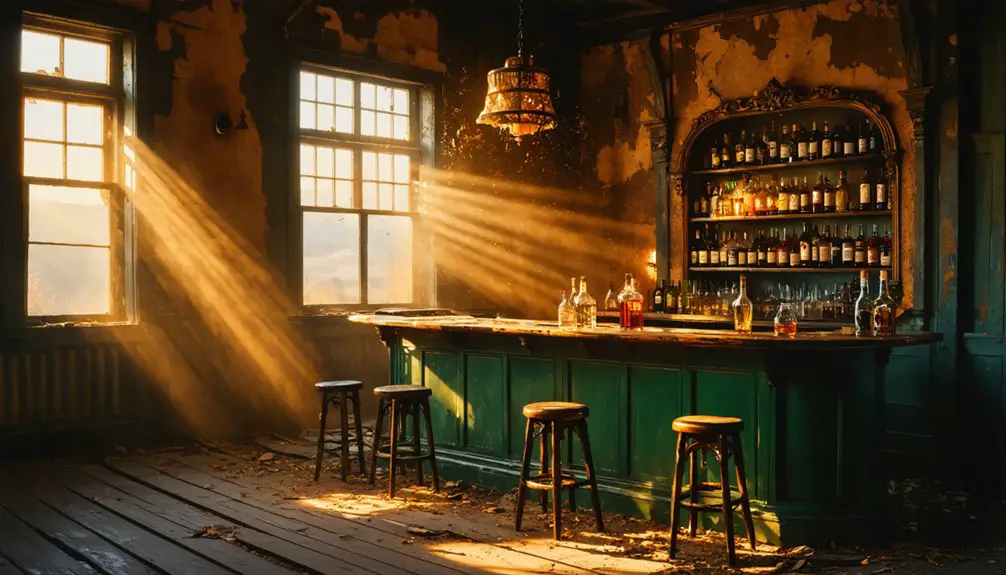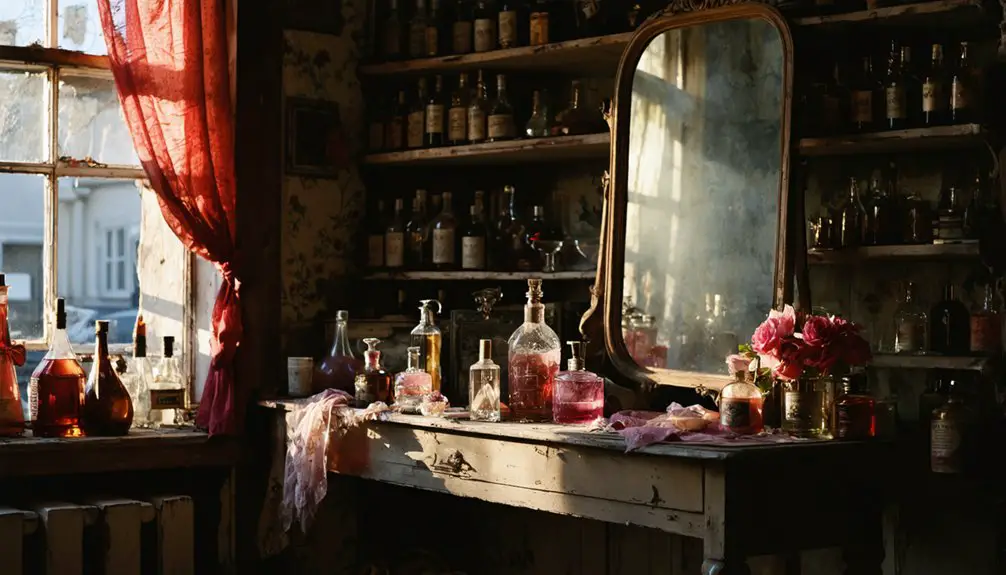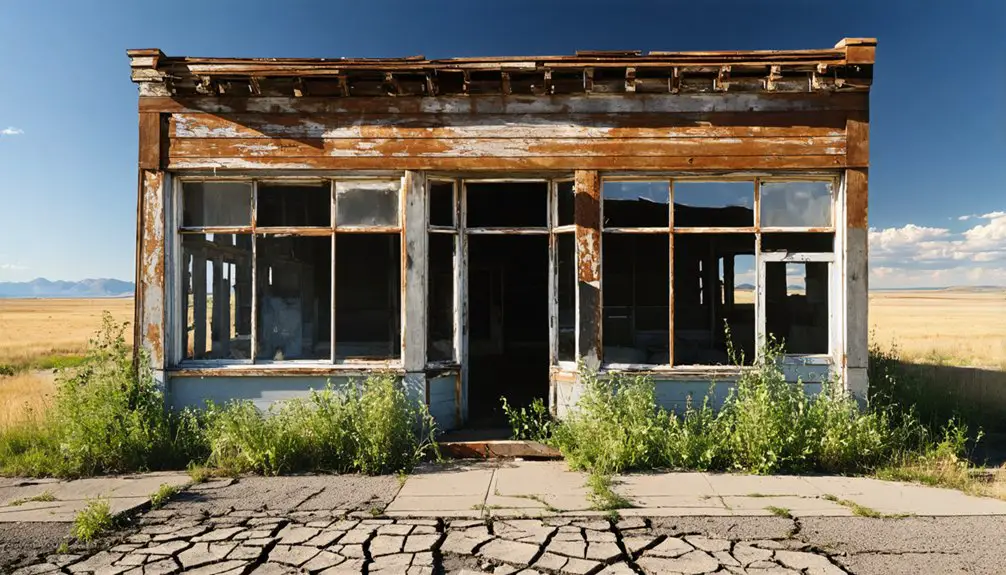You’ll find Mondak’s fascinating ruins along Montana’s eastern border, where this short-lived boomtown exploited North Dakota’s prohibition laws from 1903-1919. The strategic location near the Missouri River and Great Northern Railway helped it flourish with seven saloons, hotels, and grain elevators serving thirsty North Dakotans and weary travelers. While lawlessness and jurisdictional conflicts challenged the town’s survival, Mondak’s wild tales of vigilante justice and cross-border drama await your discovery.
Key Takeaways
- Founded in 1903 on Montana-North Dakota border as a strategic alcohol-selling town during North Dakota’s prohibition era.
- Thrived as a regional trading hub with saloons, grain elevators, and railway connections until its decline in 1919.
- Featured seven saloons and experienced frequent violent crime due to weak law enforcement and jurisdictional conflicts.
- Served as vital transportation junction where Missouri River, Yellowstone River, and Great Northern Railway intersected.
- Infrastructure included electric plant, two-story school, church, bank, and hotels before becoming a ghost town.
The Birth of a Border Town
When local investors established Mondak in 1903, they strategically positioned the town on the Montana-North Dakota border to profit from North Dakota’s prohibition laws. Their founding motivations were clear: create a haven where North Dakotans could freely purchase alcohol just steps from their dry state.
The town’s prime location near both the Missouri River and Great Northern Railway helped turn their vision into reality. State Street became the bustling heart of commerce with over a dozen saloons lining its thoroughfare. Like Bannack’s early days during the gold rush, the town experienced rapid population growth, quickly attracting diverse groups of people seeking opportunity.
You’ll find the first building appeared in 1904, and the town quickly developed its own unique dynamics. Multiple saloons, hotels, and merchants emerged to serve a growing population of farmers, workers, and visitors.
The name itself – a blend of “Montana” and “Dakota” – reflected the town’s border identity. While grain and cattle shipping contributed to the economy, it was the lucrative liquor trade that truly drove Mondak’s early growth.
A Strategic Location for Profit
Along the convergence of the Yellowstone and Missouri rivers, Mondak’s founders couldn’t have chosen a more profitable location for their enterprising town.
Similar to the first recorded brands in 1873, the Great Northern Railway‘s presence and Snowden Bridge’s connection of essential rail lines created unmatched transportation advantages for shipping local grain and cattle to major markets. The town housed hundreds of railroad workers who helped maintain these vital transportation links.
You’ll find Mondak’s most ingenious profit strategy lay in exploiting different alcohol regulations between states. While North Dakota stayed dry, Montana’s wet status allowed Mondak’s seven saloons to thrive.
Some establishments even straddled the state line, creating unique jurisdictional opportunities. Beyond liquor sales, the town developed a diversified economy with grain elevators, a bank, hotels, and general stores.
The town’s position as both a river port and rail hub cemented its role as a crucial regional trading center.
Life in the Wild West
You’d find Mondak’s nights filled with rowdy saloons where hardworking settlers sought escape, while lawmen struggled to maintain order against outlaw gangs operating along the Montana-Dakota border.
The town’s remote location made it especially challenging for sheriffs to effectively police the area, leading to frequent clashes between law enforcement and criminals drawn to the region’s isolation.
When frontier justice went awry, the community witnessed harsh vigilante actions that sometimes targeted innocent settlers alongside actual outlaws, creating an atmosphere of tension and mistrust.
Poor sanitation and widespread disease outbreaks made life in these thriving frontier towns particularly difficult for residents.
Like Virginia City’s legendary Alder Gulch mining operations, Mondak also drew fortune seekers hoping to strike it rich in the untamed West.
Lawmen vs. Outlaw Gangs
During the Wild West era, the line between lawmen and outlaws often blurred in Montana’s Mondak region, reflecting a broader pattern across the American frontier.
You’d find lawmen tactics centered on forming posses and pursuing criminals through rugged terrain, while outlaw strategies involved exploiting the sparse population and weak judicial systems to operate freely.
The region’s wealthy settlers would hire private lawmen and post bounties when centralized law enforcement proved inadequate. Just as Belle Starr demonstrated, many outlaws found safety by using their homes as secret hideouts for fugitives.
You might’ve encountered figures like the Dalton Gang, who started as law enforcers before turning to crime after payment disputes.
Local lawmen, often working alone or with minimal backup, had to confront dangerous outlaws in deadly gunfights. Cases were sometimes overseen by untrained drunk judges, reflecting the flawed justice system of the era.
These armed confrontations frequently replaced formal legal proceedings, with violent resolutions becoming the norm in maintaining frontier justice.
Saloons After Dark
When night fell across Montana’s frontier towns, saloons transformed into vibrant social hubs where cowboys, miners, and travelers gathered to escape their daily hardships.
You’d find these establishments operating around the clock, six days a week, where a nickel beer or two-bit whiskey could wash away the day’s troubles.
Inside, you’d encounter saloon girls earning their keep by selling drinks, making about $10 weekly from commission.
Despite common misconceptions, most weren’t prostitutes but independent businesswomen. These women kept things lively by entertaining with song and dance.
Saloon etiquette demanded respect for these ladies – if you stepped out of line, you’d face swift consequences from the owner or other patrons.
After hours antics typically involved friendly card games, striking business deals, or settling tabs with gold dust. Many saloons featured popular games like faro and poker.
The atmosphere remained surprisingly cooperative, with regulars forming a tight-knit community despite their rough exteriors.
Frontier Justice Gone Wrong
As Montana’s mining camps flourished in the 1860s, the absence of formal law enforcement led desperate settlers to embrace vigilante justice. You’d find committees formed after San Francisco’s model, taking the law into their own hands to combat the widespread lawlessness plaguing mining communities.
While vigilantes claimed to protect order, their actions often crossed dangerous lines. They’d execute alleged criminals without trials, and their brutal methods created an uneasy peace through fear.
What’s more troubling is how racial bias corrupted this frontier justice system. Between 1910-1920, vigilantes and local authorities murdered over 5,000 Mexican Americans, revealing the dark underbelly of Western vigilantism.
You’ll find that this “pax vigilanticus” wasn’t the romantic tale of community defense it’s often made out to be – it was a complex, often unjust system that disproportionately targeted minorities.
The Bustling Saloon Scene

Located strategically on the Montana-North Dakota border, Mondak’s bustling saloon scene emerged in 1903 as a creative response to differing state liquor laws.
You’d find more than a dozen saloons lining the Montana side of Main Street, with Jake Seel’s establishment uniquely straddling the state line – its front door in “dry” North Dakota but its bar safely in “wet” Montana.
The saloon culture defined Mondak’s identity, attracting a steady stream of thirsty North Dakotans and creating a booming economy built on drinking habits.
Inside these establishments, you’d witness a lively mix of gamblers, laborers, and travelers, though the atmosphere often turned rough.
Conductors even needed special skills to manage the rowdy crowds that packed the trains stopping in this notorious frontier town.
Law Enforcement Challenges
Mondak’s infamous reputation for lawlessness stemmed from its weak law enforcement presence and the complex jurisdictional challenges of policing a town straddling the Montana-North Dakota border.
You’ll find that violent crime rates skyrocketed as local outlaws like the Pigeon-Toed Kid and Kid Mathews took advantage of the enforcement gaps between state authorities.
Cross-border conflicts between law enforcement agencies further complicated efforts to maintain order, leaving the town’s red-light district and saloons largely unchecked.
Violent Crime Rates Soar
During its peak years between 1903 and 1919, the small frontier town of Mondak experienced an alarming surge in violent crime that would ultimately contribute to its downfall.
You’d find the town’s seven saloons and warehouses at the heart of this mayhem, where alcohol-fueled incidents regularly erupted into deadly confrontations.
- A devastating clash occurred on April 4, 1913, when J.C. Collins shot and killed both a sheriff and a deputy.
- Multiple violent incidents stemmed from widespread intoxication across the town.
- The community resorted to vigilante justice, as evidenced by Collins’ subsequent lynching.
- Illegal activities like gambling and prostitution further destabilized the social fabric.
The combination of limited law enforcement resources and a booming alcohol trade created perfect conditions for violence to flourish, making Mondak notorious for its dangerous reputation.
Cross-Border Authority Conflicts
While the booming town of Mondak straddled Montana’s border with North Dakota, its law enforcement faced complex jurisdictional challenges that mirrored today’s tribal policing struggles.
You’ll find that cross border jurisdiction created significant confusion, much like the overlapping authority between tribal police and federal BIA officers today. Law enforcement officials struggled with enforcement strategies across state lines, just as modern tribal police grapple with fractured authority over their 3,500 square miles of territory.
The town’s officers faced similar coordination hurdles that plague current reservation law enforcement, where multiple agencies clash over leadership and resource allocation.
These jurisdictional tangles led to delayed responses and ineffective crime prevention – challenges that continue to impact tribal communities today.
Behind the Red-Light District

Between the town’s main commercial strip and the river lay Mondak’s notorious red-light district, a strategic zone that capitalized on Montana’s “wet” status along the North Dakota border.
The red-light dynamics created a distinct community where you’d find brothels and saloons operating alongside each other, with innovative entrepreneurs exploiting jurisdictional loopholes to keep the liquor flowing.
- Women described as “friendly and educated” challenged typical frontier stereotypes
- Establishments straddled state lines with painted floor markings to navigate legal boundaries
- Local outlaws like the Pigeon-Toed Kid and Kid Mathews frequented the district
- Minimal law enforcement led to frequent fistfights and a reputation for frontier justice
Social interactions in the district reflected its complex nature, drawing everyone from cross-border patrons to itinerant workers, all seeking their version of freedom in this lawless corner of Montana.
Economic Rise and Infrastructure
Moving beyond the gritty social landscape, Mondak’s strategic location sparked remarkable economic growth from its establishment in 1903.
You’ll find the town’s prosperity stemmed from its position at the Montana-North Dakota border, where the Missouri River met the Great Northern Railway. This prime location fueled infrastructure development that included a bank, two hotels, grain elevators, and multiple general stores.
While alcohol sales drove the economy, with entrepreneurs cleverly positioning saloons along the state line, Mondak’s commercial foundations ran deeper.
The town boasted a part-time electric plant, a two-story brick school, and a church. Agricultural shipping thrived as local farmers and ranchers used the rail connection to send their grain and cattle to Minneapolis.
The Final Days of Mondak

Despite Mondak’s earlier success, a perfect storm of calamities struck the town in the late 1910s and 1920s. The decline dynamics accelerated when Montana enacted prohibition in 1919, shuttering the saloons that had been Mondak’s economic lifeblood.
The vibrant frontier town of Mondak crumbled under waves of misfortune, with prohibition dealing the fatal blow to its saloon-based economy.
You’d have witnessed the town’s spirit fade as businesses closed, residents departed, and crucial services vanished.
- The 1916 fires destroyed key buildings, including saloons and a warehouse
- Drought cycles devastated local agriculture starting in 1916
- The railroad station’s closure in 1924 cut off essential transportation
- Final fires in 1927-1928 razed what remained of downtown
Frequently Asked Questions
What Happened to the Original Buildings and Structures After Mondak’s Abandonment?
You’ll find most original buildings were destroyed by fires in 1916 and 1928, with no ghost town restoration attempted. Only three structures survive today, while others deteriorated naturally without building preservation efforts.
Did Any Families or Descendants of Mondak’s Original Residents Remain Nearby?
You won’t find any direct family connections to Mondak’s original residents in the area today. Local history records show most families dispersed after 1919, leaving no continuous generational presence nearby.
Were There Any Native American Interactions or Conflicts With Mondak?
You’ll find no direct Native American conflicts with Mondak. Earlier historical conflicts and treaties had already displaced tribes from the area before the town’s 1903 establishment.
What Was the Average Population of Mondak During Its Peak Years?
You’ll find that population trends during Mondak’s peak years between 1903-1919 averaged 350-400 permanent residents, though you’d see those numbers swell with transient visitors drawn to the town’s thriving liquor trade.
Did Mondak Have Any Significant Impact on Surrounding Towns’ Development?
You’ll find Mondak’s railroad influence and economic connections considerably shaped nearby towns, providing essential transport links, stimulating cross-border trade, and establishing agricultural shipping networks that neighboring communities relied on for development.
References
- https://en.wikipedia.org/wiki/Mondak
- https://www.historynet.com/ghost-town-mondak-montana-north-dakota/
- https://www.mountain-home.com/blog/vacation-planning/guide-montana’s-ghost-towns
- https://avrextravel.com/bannack-ghost-town-state-park/
- http://www.distinctlymontana.com/curious-afterlife-montanas-ghost-towns
- https://www.youtube.com/watch?v=Fn8qVQ05fAY
- https://leisuregrouptravel.com/the-gold-west-region-of-montanas-mining-heritage/
- https://www.roadunraveled.com/blog/bannack-ghost-town-montana/
- https://www.beautifulbadlandsnd.com/mondak-legendary-wild-town-sunday-snapshot/
- https://guide2museums.com/2025/05/05/mondak-heritage-center-sidney-montana/



